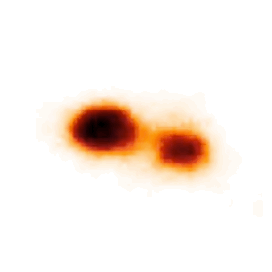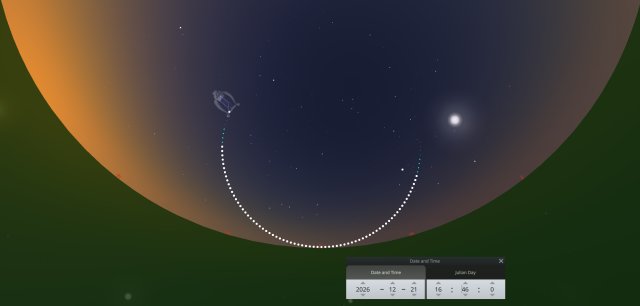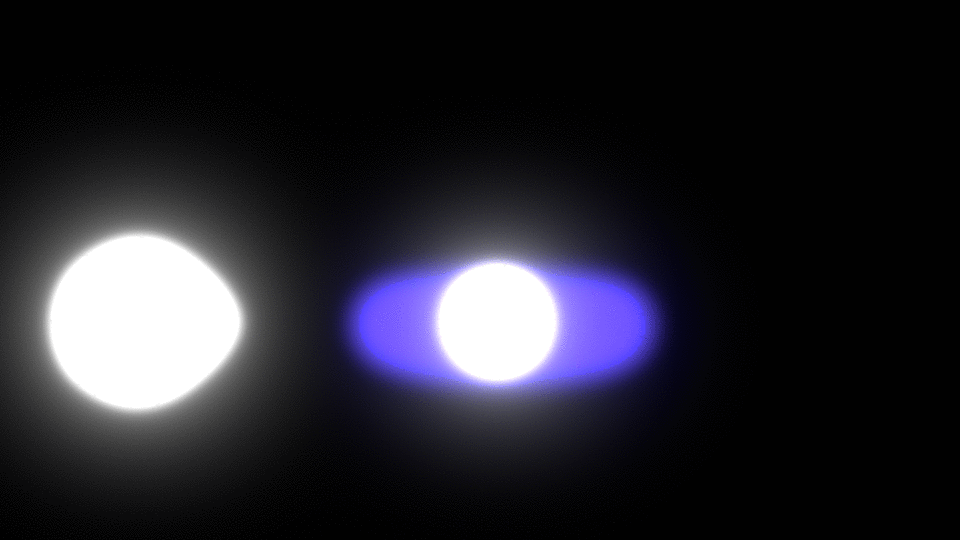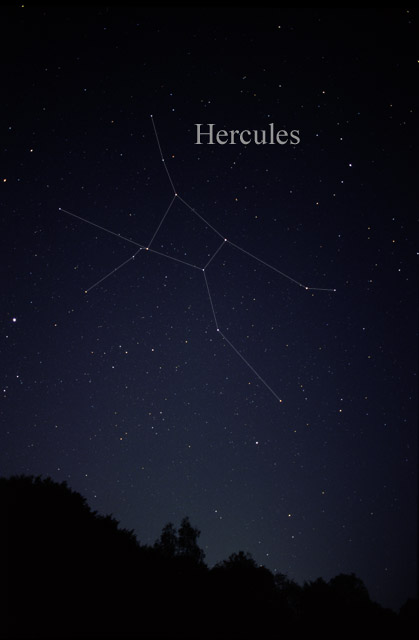|
Lyra
, from ; pronounced: ) is a small constellation. It is one of the 48 listed by the 2nd century astronomer Ptolemy, and is one of the modern 88 constellations recognized by the International Astronomical Union. Lyra was often represented on star maps as a vulture or an eagle carrying a lyre, and hence is sometimes referred to as Vultur Cadens or Aquila Cadens ("Falling Vulture" or "Falling Eagle"), respectively. Beginning at the north, Lyra is bordered by Draco, Hercules, Vulpecula, and Cygnus. Lyra is nearly overhead in temperate northern latitudes shortly after midnight at the start of summer. From the equator to about the 40th parallel south it is visible low in the northern sky during the same (thus winter) months. Vega, Lyra's brightest star, is one of the brightest stars in the night sky, and forms a corner of the famed Summer Triangle asterism. Beta Lyrae is the prototype of a class of binary stars known as Beta Lyrae variables. These binary stars are so close to ... [...More Info...] [...Related Items...] OR: [Wikipedia] [Google] [Baidu] |
Beta Lyrae
Beta Lyrae (β Lyrae, abbreviated Beta Lyr, β Lyr) officially named Sheliak (Arabic: الشلياق, Romanization: ash-Shiliyāq) ( IPA: ), the traditional name of the system, is a multiple star system in the constellation of Lyra. Based on stellar parallax, parallax measurements obtained during the Hipparcos mission, it is approximately distant from the Sun. Although it appears as a single point of light to the naked eye, it actually consists of six components of apparent magnitude 14.3 or brighter. The brightest component, designated Beta Lyrae A, is itself a triple star system, consisting of an binary star#Eclipsing binaries, eclipsing binary pair (Aa) and a single star (Ab). The binary pair's two components are designated Beta Lyrae Aa1 and Aa2. The additional five components, designated Beta Lyrae B, C, D, E, and F, are currently considered to be single stars. Nomenclature ''β Lyrae'' (Latinisation of names, Latinised to ''Beta Lyrae'') is the system's Bayer des ... [...More Info...] [...Related Items...] OR: [Wikipedia] [Google] [Baidu] |
Vega
Vega is the brightest star in the northern constellation of Lyra. It has the Bayer designation α Lyrae, which is Latinised to Alpha Lyrae and abbreviated Alpha Lyr or α Lyr. This star is relatively close at only from the Sun, and one of the most luminous stars in the Sun's neighborhood. It is the fifth-brightest star in the night sky, and the second-brightest star in the northern celestial hemisphere, after Arcturus. Vega has been extensively studied by astronomers, leading it to be termed "arguably the next most important star in the sky after the Sun". Vega was the northern pole star around 12,000 BCE and will be so again around the year 13,727, when its declination will be . Vega was the first star other than the Sun to have its image and spectrum photographed. It was one of the first stars whose distance was estimated through parallax measurements. Vega has functioned as the baseline for calibrating the photometric brightness scale and was one of the stars ... [...More Info...] [...Related Items...] OR: [Wikipedia] [Google] [Baidu] |
Epsilon Lyrae
Epsilon Lyrae (ε Lyr, ε Lyrae), also known as the Double Double, is a multiple star system of at least five stars approximately 162 light-years away in the constellation of Lyra. Star system The widest two components of the system are easily separated when viewed through binoculars, or even with the naked eye under excellent conditions. The northern component is called ε1 (ADS 11635 AB in multiple star notation) and the southern ε2 (ADS 11635 CD); they lie around 160 light years from Earth and orbit each other over hundreds of thousands of years. Their separation of is about one hundred times that of the subcomponents. When viewed at higher magnifications, each intuitively likely "star" proves to be a set of shorter-term, close-orbiting binary stars. Ability to view these sub-components is a common benchmark for the resolving power of telescopes, since they are so close together: the stars of ε1 were 2.35 arc-seconds apart in 2006, those of ε2 were separated ... [...More Info...] [...Related Items...] OR: [Wikipedia] [Google] [Baidu] |
Beta Lyrae Variable
Beta Lyrae variables are a class of close binary stars. Their total brightness is variable star, variable because the two component stars orbit each other, and in this orbit one component periodically passes in front of the other one, thereby blocking its light. The two component stars of Beta Lyrae systems are quite heavy (several solar masses () each) and extended (Giant star, giants or supergiants). They are so close, that their shapes are heavily distorted by mutual gravitation forces: the stars have ellipsoidal shapes, and there are extensive mass flows from one component to the other. Mass flows These mass flows occur because one of the stars, in the course of its stellar evolution, evolution, has become a giant or supergiant. Such extended stars easily lose mass, just because they are so large: gravitation at their surface is weak, so gas easily escapes (the so-called stellar wind). In close binary systems such as beta Lyrae systems, a second effect reinforces this mass lo ... [...More Info...] [...Related Items...] OR: [Wikipedia] [Google] [Baidu] |
Ring Nebula
The Ring Nebula (also catalogued as Messier 57, M57 and NGC 6720) is a planetary nebula in the northern constellation of Lyra , from ; pronounced: ) is a small constellation. It is one of the 48 listed by the 2nd century astronomer Ptolemy, and is one of the modern 88 constellations recognized by the International Astronomical Union. Lyra was often represented on star .... Such a nebula is formed when a star, during the last stages of its stellar evolution, evolution before becoming a white dwarf, expels a vast luminous envelope of ionized gas into the surrounding interstellar space. History This nebula was discovered by the French astronomer Charles Messier while searching for comets in late January 1779. Messier's report of his independent discovery of Comet Bode reached fellow French astronomer Antoine Darquier de Pellepoix two weeks later, who then independently rediscovered the nebula while following the comet. Darquier later reported that it was "...as large as Jupite ... [...More Info...] [...Related Items...] OR: [Wikipedia] [Google] [Baidu] |
Hercules (constellation)
Hercules is a constellation named after Hercules, the Roman mythology hero adapted from the Greek mythology, Greek hero Heracles. Hercules was one of the 48 constellations listed by the second-century astronomer Ptolemy, and it remains one of the IAU designated constellations, 88 modern constellations today. It is the fifth-largest of the modern constellations and is the largest of List of brightest stars, the 50 which have no stars brighter than apparent Magnitude (astronomy), magnitude +2.5. Characteristics Hercules is bordered by Draco (constellation), Draco to the north; Boötes, Corona Borealis, and Serpens, Serpens Caput to the west; Ophiuchus to the south; Aquila (constellation), Aquila to the southwest; and Sagitta, Vulpecula, and Lyra to the east. Covering 1225.1 square degrees and 2.970% of the night sky, it ranks fifth among the 88 constellations in size. The three-letter abbreviation for the constellation, as adopted by the International Astronomical Union in 192 ... [...More Info...] [...Related Items...] OR: [Wikipedia] [Google] [Baidu] |
2MASS 1835+3259
LSR J1835+3259 is a nearby ultracool dwarf of spectral class M8.5, located in constellation Lyra, the discovery of which was published in 2003. Previously it was concluded that this star is a young brown dwarf, but no lithium absorption lines are detected for this object, which is a strong indicator for young brown dwarfs that need 10–100 million years to deplete lithium. Distance Trigonometric parallax of this object, measured in 2001–2002 with the USNO 61 inch (1.5 m) reflector under US Naval Observatory (USNO) parallax program, is 0.1765 ± 0.0005 arcsec, corresponding to a distance of 5.67 ± 0.02 pc, or 18.48 ± 0.05 ly. Characteristics The first potential extrasolar auroras detected occurred in the atmosphere of LSR J1835+3259. They were found in July 2015 by the Karl G. Jansky Very Large Array in New Mexico by analyzing the emitted radio waves. The potential auroras were probably 1 million times brighter than those ever observed on Earth. T ... [...More Info...] [...Related Items...] OR: [Wikipedia] [Google] [Baidu] |
Cygnus (constellation)
Cygnus is a northern constellation on the plane of the Milky Way, deriving its name from the Latinisation of names, Latinized Greek language, Greek word for swan. Cygnus is one of the most recognizable constellations of the northern summer and autumn, and it features a prominent asterism (astronomy), asterism known as the Northern Cross (asterism), Northern Cross (in contrast to the Southern Cross). Cygnus was among the 48 constellations listed by the 2nd century astronomer Ptolemy, and it remains one of the 88 modern constellations. Cygnus contains Deneb (ذنب, translit. ''ḏanab,'' tail)one of the brightest stars in the night sky and the most distant first-magnitude staras its "tail star" and one corner of the Summer Triangle the constellation forming an east pointing Altitude (triangle), altitude of the triangle. It also has some notable X-ray sources and the giant stellar association of Cygnus OB2. One of the stars of this association, NML Cygni, is one of the List of larg ... [...More Info...] [...Related Items...] OR: [Wikipedia] [Google] [Baidu] |
Binary Star
A binary star or binary star system is a system of two stars that are gravitationally bound to and in orbit around each other. Binary stars in the night sky that are seen as a single object to the naked eye are often resolved as separate stars using a telescope, in which case they are called ''visual binaries''. Many visual binaries have long orbital periods of several centuries or millennia and therefore have orbits which are uncertain or poorly known. They may also be detected by indirect techniques, such as spectroscopy (''spectroscopic binaries'') or astrometry (''astrometric binaries''). If a binary star happens to orbit in a plane along our line of sight, its components will eclipse and transit each other; these pairs are called ''eclipsing binaries'', or, together with other binaries that change brightness as they orbit, ''photometric binaries''. If components in binary star systems are close enough, they can gravitationally distort each other's outer stellar atmospheres. ... [...More Info...] [...Related Items...] OR: [Wikipedia] [Google] [Baidu] |
Summer Triangle
The Summer Triangle is an astronomical asterism in the northern celestial hemisphere. The defining vertices of this imaginary triangle are at Altair, Deneb, and Vega, each of which is the brightest star of its constellation ( Aquila, Cygnus, and Lyra, respectively). The greatest declination is +45° and lowest is +9° meaning the three can be seen from all places in the Northern Hemisphere and from the home of most people resident in the Southern Hemisphere. The two stars in Aquila and Cygnus represent the head of an eagle and tail of a swan that looks east inscribed into the triangle and forming the altitude of the triangle. Two small constellations, Sagitta and Vulpecula, lie between Aquila in the south of the triangle and Cygnus and Lyra to the north. History The term was popularized by the American author H. A. Rey and the British astronomer Patrick Moore in the 1950s. The name can be found in constellation guidebooks as far back as 1913. The Austrian astronomer ... [...More Info...] [...Related Items...] OR: [Wikipedia] [Google] [Baidu] |
Vulpecula
Vulpecula is a faint constellation in the northern sky. Its name is Latin for "little fox", although it is commonly known simply as the fox. It was identified in the seventeenth century, and is located in the middle of the Summer Triangle (an asterism consisting of the bright stars Deneb, Vega, and Altair). Features Stars There are no stars brighter than 4th magnitude in this constellation. The brightest star in Vulpecula is Alpha Vulpeculae, a magnitude 4.44m red giant at an approximate distance of 291 light-years. The star is an optical binary (separation of 413.7") that can be split using binoculars. The star also carries the traditional name Anser, which refers to the goose the little fox holds in its jaws. 23 Vulpeculae is the second brightest star in the constellation. In 1967, the first pulsar, PSR B1919+21, was discovered in Vulpecula by Jocelyn Bell, supervised by Antony Hewish, in Cambridge. While they were searching for scintillation of radio signals ... [...More Info...] [...Related Items...] OR: [Wikipedia] [Google] [Baidu] |
Lyre
The lyre () (from Greek λύρα and Latin ''lyra)'' is a string instrument, stringed musical instrument that is classified by Hornbostel–Sachs as a member of the History of lute-family instruments, lute family of instruments. In organology, a lyre is considered a yoke lute, since it is a lute in which the strings are attached to a yoke that lies in the same plane as the sound table, and consists of two arms and a crossbar. The lyre has its origins in ancient history. Lyres were used in several ancient cultures surrounding the Mediterranean Sea. The earliest known examples of the lyre have been recovered at archeological sites that date to c. 2700 BCE in Mesopotamia. The oldest lyres from the Fertile Crescent are known as the eastern lyres and are distinguished from other ancient lyres by their flat base. They have been found at archaeological sites in Egypt, Syria, Anatolia, and the Levant. In a discussion of the Nubian lyre, Carl Engel notes that modern Egyptians call it ... [...More Info...] [...Related Items...] OR: [Wikipedia] [Google] [Baidu] |











